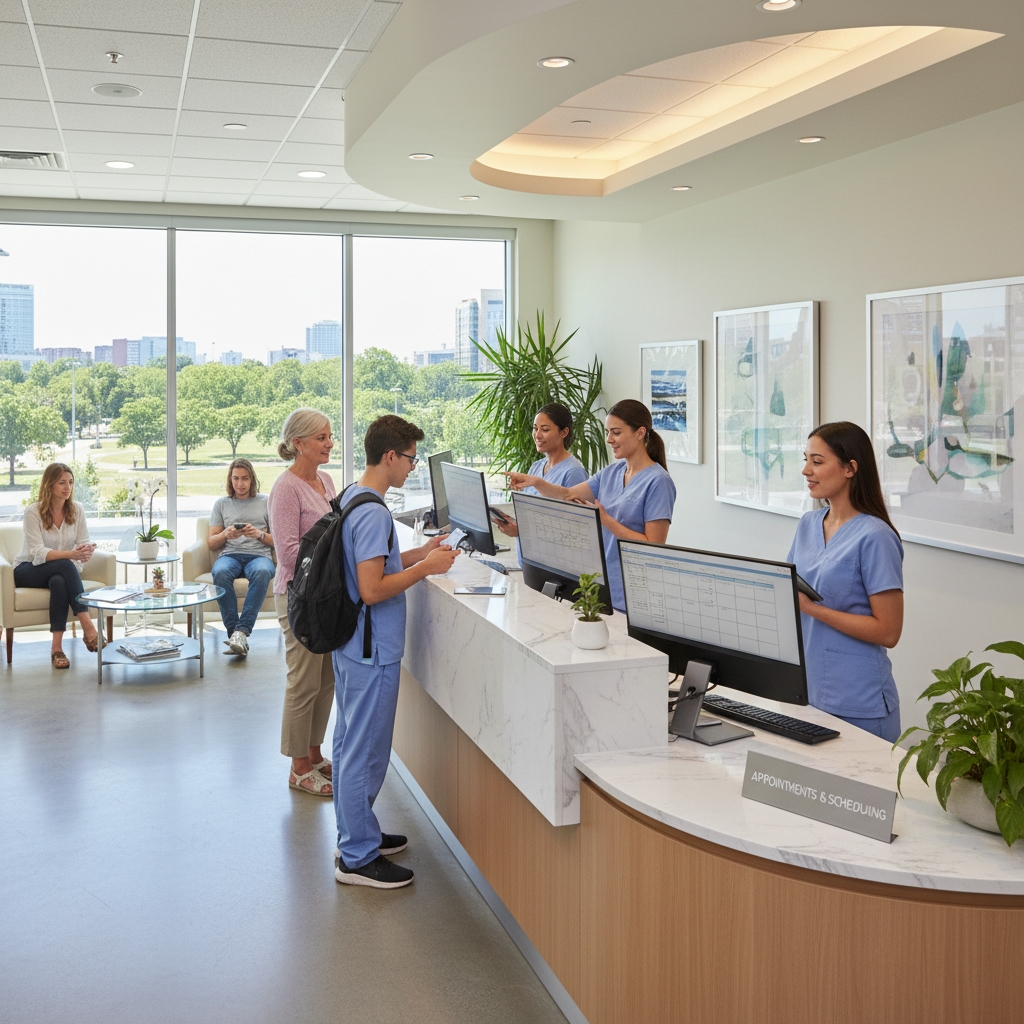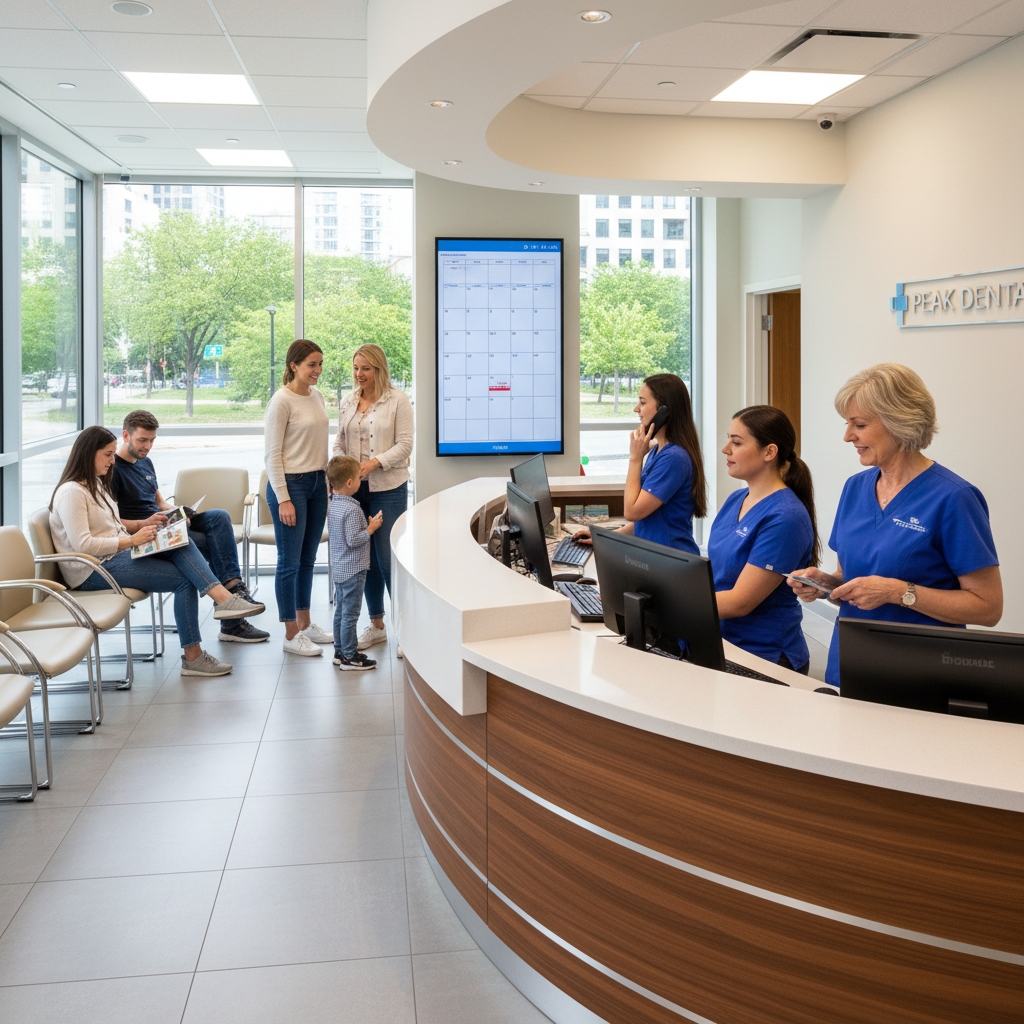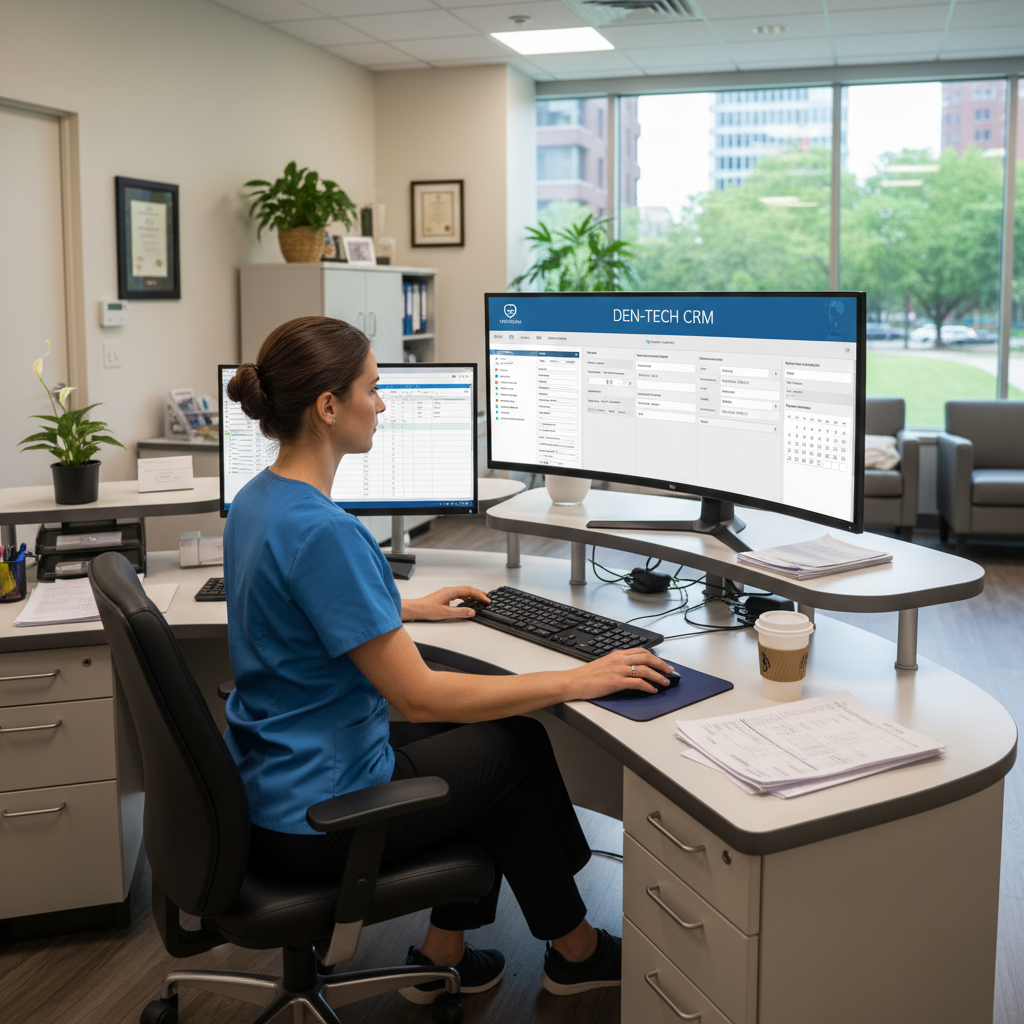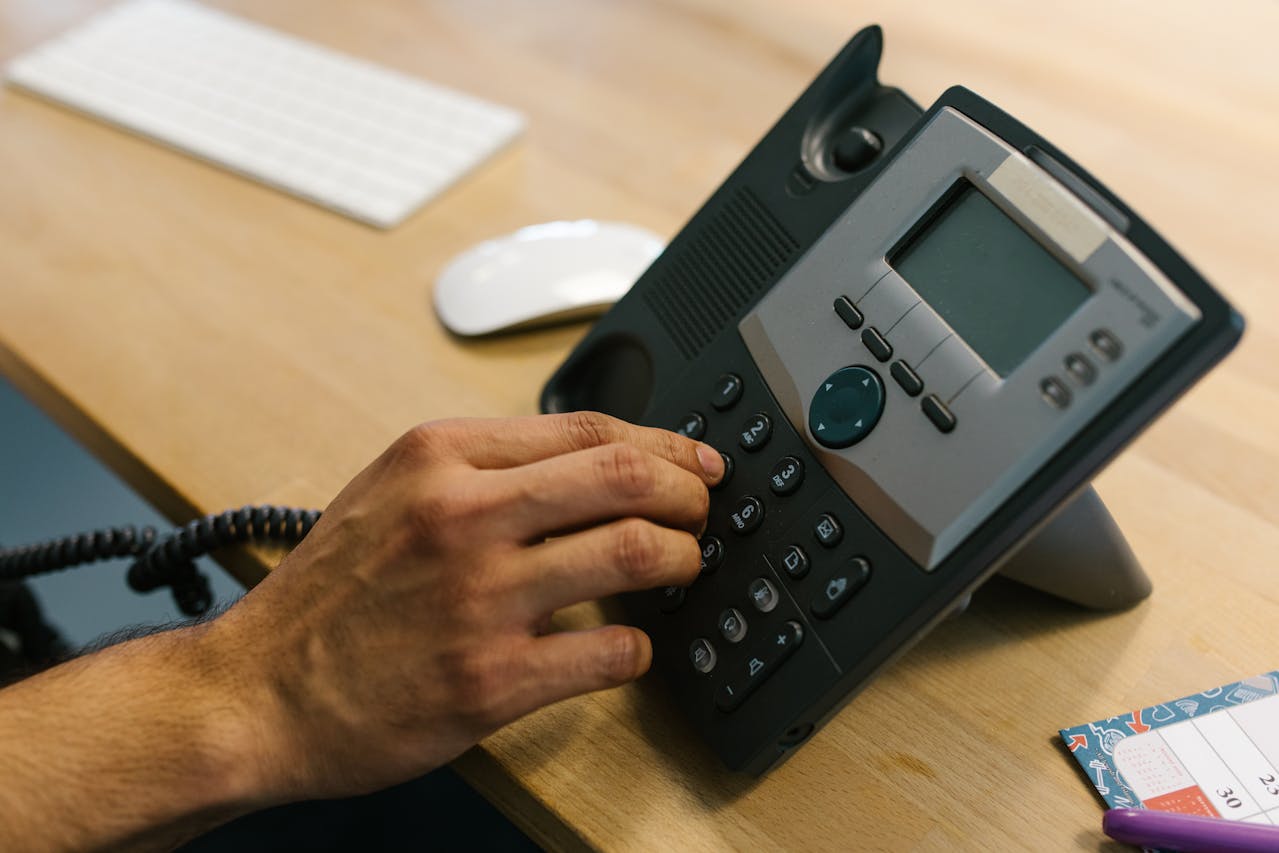












Blog Article


How to Reduce Staff Workload with Automated Call Responses - Guide For Dentists and DSOs
Dental practices lose thousands of dollars each month from missed calls and appointment no-shows. Staff members spend countless hours answering routine questions about office hours, insurance coverage, and appointment availability instead of focusing on patient care.
Automated call responses can reduce front desk workload by up to 70% while capturing more appointments and improving patient satisfaction. These systems handle routine inquiries 24/7, confirm appointments automatically, and route urgent calls to appropriate staff members.
Modern call center automation technology has evolved beyond simple phone trees to include intelligent conversation handling that feels natural to patients. Healthcare practices that implement these solutions see immediate improvements in staff efficiency and patient engagement rates.
Key Takeaways
- Automated call systems handle routine patient inquiries around the clock, freeing staff to focus on in-person patient care
- Intelligent call routing and appointment confirmation features significantly reduce no-shows and missed revenue opportunities
- Integration with practice management systems creates seamless workflows that improve both staff productivity and patient experience
Automated Call Responses for Dental Practices
Dental practices miss approximately 30-35% of incoming calls during regular office hours, resulting in significant revenue losses. Modern automated call answering systems eliminate these gaps while reducing administrative burden on front desk teams through intelligent call routing and patient self-service options.
Why Automate Call Handling in Dental Clinics
Staff members often juggle multiple tasks simultaneously, from checking in patients to processing insurance claims. When phone calls interrupt these activities, it creates bottlenecks that slow down office operations.
Automated systems handle routine inquiries without human intervention. Patients can schedule appointments, receive office directions, and access billing information through interactive voice response (IVR) systems.
High call volumes during peak hours overwhelm front desk teams:
- Monday morning appointment requests
- After-school scheduling for pediatric patients
- Emergency calls during lunch breaks
- Insurance verification inquiries
Manual call handling requires staff to repeat the same information dozens of times daily. Automation reduces this repetitive workload while maintaining consistent service quality.
Call abandonment rates increase when patients wait on hold too long. Automated responses provide immediate acknowledgment and route callers to appropriate resources based on their needs.
Key Benefits for DSOs and Practice Owners
Large dental organizations manage thousands of patient interactions across multiple locations. Standardized automated responses ensure consistent communication regardless of which office patients contact.
Cost reduction occurs through several channels:
- Reduced staffing needs for phone coverage
- Elimination of after-hours answering services
- Decreased training time for new employees
- Lower employee turnover from reduced stress
Revenue protection happens when every call receives attention. Automated systems capture patient information even when human staff cannot answer immediately.
Multi-location practices benefit from centralized call management. One system can handle overflow from busy offices and distribute calls to available locations.
Patient satisfaction improves when wait times decrease. Automated systems provide instant responses rather than lengthy hold periods that frustrate callers.
DSOs report specific operational improvements:
- 24/7 availability without additional labor costs
- Consistent branding across all practice locations
- Scalable solutions that grow with practice expansion
How Automated Responses Reduce Staff Workload
Front desk employees spend significant time on repetitive phone tasks that automation handles efficiently. Basic appointment scheduling, cancellations, and rescheduling requests process without staff involvement.
Digital forms save up to 50 staff hours per month by eliminating manual data entry. Patients complete intake paperwork through automated systems before their appointments.
IVR systems categorize calls automatically:
- Emergency situations route to on-call providers
- Billing questions direct to financial coordinators
- New patient inquiries connect to scheduling staff
- Prescription requests reach clinical team members
Staff members focus on complex tasks that require human judgment. Simple information requests get handled through pre-recorded responses or automated text systems.
Appointment confirmations and reminders send automatically through multiple channels. This eliminates dozens of outbound calls that staff previously made manually.
Call volume distribution becomes more manageable when automation handles:
- Basic office information (hours, location, parking)
- Insurance acceptance verification
- Service descriptions and pricing estimates
- Post-treatment care instructions
Teams experience less interruption during patient care activities. Critical calls still reach staff immediately while routine matters process through automated workflows.
Missed Calls: Impact on Dental Revenue
Dental practices lose substantial revenue when patient calls go unanswered, with studies showing offices can lose $100,000 to $150,000 annually from missed opportunities. The financial consequences extend beyond immediate appointment losses to long-term patient retention issues.
Missed Call Statistics in Dentistry
Industry Data on Missed Calls
- 30-35% of calls to dental offices go unanswered
- 67-80% of patients hang up without leaving voicemail messages
- Most patients do not call back after reaching voicemail
Peak Times for Missed Calls
- Monday mornings and lunch hours see highest call volumes
- After-hours calls represent 25-30% of total daily call attempts
- Holiday periods show increased missed call rates due to limited staffing
Patient Response Patterns Research shows patients typically try only one alternative provider before booking elsewhere. This means missed calls create immediate competitive disadvantages for practices.
Call centers and traditional phone systems often drop 15-25% of incoming calls during busy periods. Understaffing during peak hours compounds this problem, especially in smaller practices with limited front desk coverage.
How Missed Calls Affect Production
New Patient Revenue Loss Each new patient generates approximately $850 in their first year. With 30-35% of calls missed, practices lose significant new patient acquisition opportunities daily.
Current Patient Impact
- Increased no-shows due to inability to confirm appointments
- Patients switching to competitors with better phone accessibility
- Reduced treatment plan acceptance from poor communication
Staff Productivity Costs Front desk staff spend 60-70% of their time handling phone calls and appointments. This heavy workload leads to:
Impact Area Cost Effect
Staff turnover Higher hiring/training costs
Overtime hours Increased labor expenses
Patient satisfaction Reduced referral rates
Long-term Financial Impact Over seven years, some practices could lose more than $700,000 from consistently missed calls. This calculation includes both immediate appointment losses and reduced patient lifetime value from poor accessibility.
Recovering Lost Revenue with Automation
Automated Response Systems AI-powered phone systems can handle multiple calls simultaneously, ensuring no patient inquiry goes unanswered. These systems work 24/7, capturing after-hours appointment requests that traditional staffing cannot accommodate.
Revenue Recovery Results Practices using automated call responses report:
- 87-90% reduction in missed calls
- 20-35% increase in booked appointments
- 12% overall revenue increase
Implementation Benefits Automated systems integrate with practice management software like Dentrix and Eaglesoft. This allows real-time appointment scheduling without staff intervention.
Modern dental practices and DSOs use automated phone systems to capture every potential patient interaction. The technology reduces staff workload while increasing patient satisfaction through consistent availability.
Cost Savings Beyond Revenue Recovery
- Reduced need for additional reception staff saves approximately $45,000 annually
- Automated appointment reminders decrease no-shows by 30-45%
- Lower staff turnover from reduced phone call stress
Reducing No-Shows with Automated Call Responses
Automated call systems cut patient no-shows by up to 40% while eliminating manual reminder calls that consume staff time. Practices implementing automated reminders typically see a 30-40% drop in no-shows when patients receive timely notifications through their preferred communication channels.
Automated Reminders and Patient Follow-Up
Dental practices benefit from multi-channel reminder systems that contact patients through text, email, and phone calls. These systems send reminders at optimal intervals - typically 48 hours, 24 hours, and 2 hours before scheduled appointments.
Effective reminder timing includes:
- Initial confirmation 48-72 hours prior
- Second reminder 24 hours before
- Final reminder 2-4 hours ahead of appointment
Smart reminder systems track patient response patterns and adjust communication preferences automatically. Some patients respond better to morning texts while others prefer evening phone calls.
AI reduces no-shows by sending smart, personalized reminders that match individual patient communication styles. The technology learns from patient behavior and optimizes message timing for maximum effectiveness.
Call routing features direct reminder responses to appropriate staff members. When patients need to reschedule, the system automatically routes calls to scheduling coordinators rather than clinical staff.
Appointment Booking Automation
Online scheduling eliminates phone tag between patients and staff while reducing last-minute cancellations. Patients can view real-time availability and book appointments outside normal business hours.
Automated booking systems prevent double-scheduling by checking provider availability, room assignments, and equipment needs in real-time. The software blocks inappropriate appointments automatically - preventing 30-minute slots for procedures requiring 90 minutes.
Key automation features:
- Real-time calendar synchronization
- Automatic buffer time between appointments
- Patient history integration for appropriate scheduling
- Insurance verification during booking process
Waitlist automation fills canceled slots within minutes of notification. When patients cancel, the system immediately contacts waitlisted patients via their preferred communication method.
Automated workflow systems help practices reduce no-shows from 28% to 11% through strategic reminder sequences and flexible rescheduling options.
Minimizing No-Shows for Dentists
Emergency call handling prevents patient loss during off-hours when dental pain strikes. Automated systems screen urgent cases and provide immediate appointment booking capabilities for genuine emergencies.
The technology distinguishes between routine inquiries and urgent situations through call routing algorithms. Emergency calls receive priority handling while routine questions get appropriate automated responses.
Call screening criteria:
- Pain level assessment questions
- Symptom duration and severity
- Previous treatment history review
- Insurance and payment verification
Same-day confirmation calls work effectively for high-value procedures. Staff can focus confirmation efforts on expensive treatments while automated systems handle routine cleanings and checkups.
Flexible rescheduling policies encourage advance notice from patients. When systems make rescheduling easy through online portals or simple phone prompts, patients provide longer cancellation lead times that allow practices to fill slots from waitlists.
Integrating Automated Call Solutions With PMS
Modern automated call systems connect directly with practice management software through APIs and webhooks, enabling real-time appointment booking and patient data synchronization. These integrations eliminate manual data entry while maintaining accurate scheduling across multiple locations.
Direct Booking Into Practice Management Software
Automated call systems integrate with popular dental PMS platforms like Dentrix, Eaglesoft, and Open Dental through secure API connections. These integrations allow patients to schedule appointments directly during phone calls without staff intervention.
Key Integration Features:
- Real-time appointment availability checks
- Automatic patient record updates
- Insurance verification during booking
- Confirmation messages sent automatically
The system pulls available time slots from the PMS and books appointments instantly. Patient information flows directly into existing records, reducing duplicate entries and scheduling errors.
Streamlined operations through automation reduce manual workload significantly. Staff members can focus on complex patient care instead of routine scheduling tasks.
Most integrations require minimal setup time. IT teams configure webhook connections that trigger automatic data transfers between systems.
Custom Integrations for Multi-Location Practices
DSOs managing multiple locations need centralized booking systems that work across different practice management platforms. Custom integrations handle complex routing rules and location-specific scheduling requirements.
Multi-Location Benefits:
- Centralized patient database access
- Cross-location appointment transfers
- Standardized booking procedures
- Unified reporting across practices
Zapier connections enable practices to link automated call systems with various PMS platforms simultaneously. These workflows trigger specific actions based on location, provider availability, and appointment type.
Large DSOs often require custom API development for unique operational needs. These solutions integrate patient communication preferences, insurance networks, and specialty scheduling requirements.
The integration maintains separate calendars while allowing centralized management. Patients calling any location can access appointments across the entire network when appropriate.
Streamlining Schedule Management
Automated systems sync with PMS calendars in real-time, preventing double-bookings and scheduling conflicts. The integration updates appointment statuses, cancellations, and rescheduling requests automatically.
Schedule Management Features:
- Automatic appointment confirmations
- Cancellation processing without staff input
- Waitlist management for popular time slots
- Buffer time adjustments between appointments
The system handles routine schedule changes through call center automation workflows. Staff receive notifications only for complex scheduling issues requiring human intervention.
Integration with billing systems ensures accurate patient information transfers to insurance claims. Appointment details, procedure codes, and provider notes sync automatically after each visit.
Common PMS Integrations:
PMS Platform Integration Type Setup Time
Dentrix Direct API 2-3 days
Eaglesoft Webhook 1-2 days
Open Dental Custom API 3-5 days
Curve Direct Integration 1 day
Real-time synchronization eliminates scheduling delays and reduces patient wait times. The automated system maintains accurate appointment books across all connected platforms without manual oversight.
Enhancing Patient Experience with Empathetic Messaging
Automated call responses can deliver caring, personalized messages that actually improve patient satisfaction scores. Modern systems use context-aware technology to send follow-ups that feel natural and help gather essential scheduling information.
Human-Tone Auto-Texts After Missed Calls
Dental practices lose potential patients when calls go unanswered during busy periods. AI-generated responses receive higher empathy ratings than traditional human responses, with patients rating them as more caring and informative.
Automated text messages after missed calls should include:
- Warm acknowledgment of the call attempt
- Specific practice hours for callbacks
- Direct scheduling link for urgent appointments
- Emergency contact information for after-hours needs
These messages reduce customer frustration from long hold times. They show the practice values patient time even when staff cannot immediately answer.
The key lies in message tone. Instead of "We missed your call," practices can send "Thanks for calling! We'd love to help schedule your appointment." This approach maintains the personal touch patients expect from their dental office.
Context matters too. Messages for existing patients can reference their last visit or upcoming cleaning. New patient messages should focus on welcoming them to the practice and explaining next steps.
Context-Aware Chats for Patient Queries
Smart messaging systems access patient records to provide relevant responses without compromising privacy. When patients ask about appointment availability, the system can suggest times based on their treatment history and preferences.
Common patient queries that benefit from context-aware responses:
Query Type Context Used Response Example
Appointment scheduling Previous visit type "Your next cleaning is due - we have Tuesday 2pm available"
Treatment follow-up Recent procedures "How is your crown feeling? Any sensitivity to report?"
Insurance questions Coverage on file "Your Delta Dental covers 80% of this procedure"
These systems reduce back-and-forth messaging that frustrates both patients and staff. Patients get accurate information immediately rather than waiting for callbacks.
Effective communication protocols improve patient safety by ensuring important details reach the right people quickly. Automated systems can flag urgent symptoms or pain levels for immediate staff review.
The technology works best when integrated with practice management software. This allows real-time access to schedules, insurance information, and treatment plans without manual data entry.
Gathering Visit Details and Best Times
Automated messaging excels at collecting patient information before appointments. This reduces check-in time and helps staff prepare for each visit efficiently.
Pre-visit messages can gather:
- Current symptoms or pain levels
- Medication changes since last visit
- Preferred appointment times for future scheduling
- Insurance updates or card changes
The system can send different questionnaires based on appointment type. Routine cleanings need basic health updates. Complex procedures require more detailed medical history reviews.
Timing matters for these messages. Send initial requests 48 hours before appointments. Follow up 24 hours later if patients haven't responded. This gives enough time for staff review without overwhelming patients.
Customer satisfaction improves when patients feel prepared for their visits. They arrive knowing what to expect and have already provided necessary information. This creates smoother appointments for everyone involved.
Practices can also use these interactions to confirm contact preferences. Some patients prefer texts while others want phone calls. Automated systems can track these preferences and adjust future communications accordingly.
Analytics and Revenue Attribution for Dental Clinics
Modern automated call systems provide detailed data on every patient interaction and missed opportunity. Call transcription technology helps practices track conversion rates from phone inquiries to scheduled appointments.
Measuring Call Response Performance
Automated call systems track key metrics that directly impact practice revenue. Response time, call duration, and resolution rates provide clear insight into patient experience quality.
Most systems record average response time within 2-3 seconds for automated answers versus 6-8 rings for traditional phone handling. Call completion rates typically improve by 40-60% with automated responses compared to human-only systems.
Conversion tracking measures how many callers schedule appointments after initial contact. Practices see conversion rates between 65-85% for automated systems with proper call routing.
Key performance indicators include:
- First-call resolution rate
- Appointment booking percentage
- Call abandonment rate
- Peak call volume times
Dental practice analytics help track revenue trends and collection rates beyond basic call metrics.
Missed-Call Heatmaps and Dashboard Tracking
Visual dashboards show exactly when patients call but cannot reach the practice. Heatmaps display missed call patterns by hour, day, and week to identify staffing gaps.
Most practices discover 20-30% of calls occur outside business hours. Tuesday through Thursday typically show the highest call volumes between 9 AM and 2 PM.
Dashboard features track:
- Real-time missed call alerts
- Geographic caller distribution
- Repeat caller identification
- Seasonal appointment trends
Call summaries provide quick overviews of patient needs without listening to full recordings. Transcription services convert voice messages into readable text for faster staff review.
Practices can adjust staffing schedules based on actual call data rather than estimates. Peak time identification helps optimize staff coverage during high-demand periods.
Quantifying Revenue From Recovered Calls
Automated systems convert missed calls into scheduled appointments that generate measurable revenue. Each recovered call represents potential treatment value ranging from $200-2,000 depending on service complexity.
Practices track revenue attribution by connecting phone calls to completed treatments. Understanding marketing attribution through call information helps dental offices improve patient communication and secure more appointments.
Revenue calculation methods:
- Average treatment value per new patient
- Conversion rate from call to appointment
- Show-up rate for scheduled visits
- Treatment acceptance percentage
Most practices see 15-25% revenue increases within 90 days of implementing automated call recovery systems. Emergency calls recovered after hours often generate higher-value treatments due to urgent care needs.
Monthly reporting shows which time periods produce the most valuable recovered calls. This data helps practices prioritize automated response improvements during peak revenue opportunities.
AI Agents to Support Front Desk and DSOs
AI agents equipped with speech recognition and natural language processing capabilities can handle routine patient interactions while human staff focus on complex clinical tasks. These digital assistants manage appointment scheduling, insurance verification, and patient follow-ups across multiple dental practice locations.
Augmenting Staff With Automated AI Agents
Virtual receptionists powered by natural language processing can handle up to 80% of routine patient calls without human intervention. These AI systems use speech recognition to understand patient requests and respond with appropriate scheduling or information.
Core Functions AI Agents Handle:
- Appointment booking and rescheduling
- Insurance verification calls
- Payment reminders and collection
- Post-treatment follow-ups
- Basic FAQs about services
AI scheduling platforms reduce call volumes by up to 40% by offering 24/7 self-service options. Patients can book appointments outside business hours without waiting for staff availability.
The NLP technology allows these agents to understand context and handle multi-step conversations. They can escalate complex issues to human staff while maintaining conversation history for seamless handoffs.
Role of White-Label and Custom Solutions
White-label AI solutions allow DSOs to maintain brand consistency across all practice locations while implementing standardized automation protocols. These systems can be configured with practice-specific scheduling rules, insurance policies, and treatment information.
Custom AI agents learn each practice's unique workflows and patient demographics. They adapt to local appointment preferences, common procedures, and specific insurance requirements for different regions.
Implementation Considerations:
- HIPAA compliance and data security protocols
- Integration with existing practice management software
- Customizable scripts for different specialties
- Multi-language support for diverse patient populations
DSOs benefit from centralized training and management of AI systems while maintaining individual practice autonomy. The white-label approach reduces implementation costs and training time compared to building custom solutions from scratch.
Multi-Location Roll-Out Best Practices
Successful DSO implementations start with pilot programs at 2-3 locations before full network deployment. This approach identifies technical issues and staff training needs without disrupting entire operations.
Phased Implementation Strategy:
- Week 1-2: Install and configure AI systems
- Week 3-4: Staff training and parallel operations
- Week 5-6: Gradual transition to AI-first responses
- Week 7-8: Performance monitoring and optimization
AI communications platforms deliver comprehensive automation across all patient touchpoints rather than point solutions for single tasks. These integrated systems provide consistent reporting and management across multiple practice locations.
Change management becomes critical when implementing AI across multiple sites. Staff need clear guidelines on when to intervene and how to work alongside automated systems effectively.
Regular performance reviews ensure AI agents maintain quality standards across all locations. DSOs should establish metrics for call resolution rates, patient satisfaction, and appointment conversion percentages.
Why Dentists and DSOs Are Choosing Resonate
Resonate offers dental practices and DSOs comprehensive AI-powered call management solutions that reduce staff workload while capturing every patient interaction. The platform combines virtual receptionist capabilities, intelligent chatbots, and detailed analytics to address the challenges of missed patient calls and staff overload.
Positioning of Resonate for Patient Engagement
Resonate positions itself as a specialized AI solution designed specifically for dental practices and multi-location DSOs. The platform understands the unique challenges dental offices face with appointment scheduling and emergency calls.
The system handles complex dental terminology and appointment types automatically. It knows the difference between routine cleanings, emergency procedures, and specialist consultations. This dental-specific knowledge allows more accurate scheduling and patient communication.
Key positioning advantages include:
- 24/7 availability for patient calls
- Dental industry-specific training
- Integration with major practice management systems
- Scalable solutions for single practices and DSOs
The platform targets practices that lose revenue from unanswered calls during peak hours. It serves as an extension of existing front desk teams rather than a replacement.
Key Features: Virtual Receptionist, Chatbot, Analytics
Resonate's virtual receptionist technology answers patient calls instantly and handles appointment scheduling without human intervention. The system provides natural conversation flows that patients cannot distinguish from human receptionists.
The chatbot functionality extends patient engagement beyond phone calls. Patients can schedule appointments, ask questions about services, and receive appointment reminders through automated text messaging systems.
Core feature breakdown:
- Call answering - Handles 100% of incoming calls
- Appointment booking - Direct calendar integration
- Patient communication - Two-way texting capabilities
- Analytics dashboard - Real-time performance metrics
Analytics features provide detailed insights into call patterns, missed opportunities, and revenue attribution. Practice managers can identify peak call times and optimize staffing schedules based on actual data.
The system tracks conversion rates from calls to appointments. This data helps DSOs maximize efficiency across multiple locations with centralized reporting capabilities.
Addressing Staff Workload and Missed Calls
Resonate directly tackles the problem of front desk staff handling overwhelming call volumes during busy periods. The system captures calls that would otherwise go to voicemail or be abandoned by impatient patients.
Staff members can focus on in-person patient care while the AI handles routine scheduling and information requests. This reduces burnout and improves job satisfaction among front desk teams.
The platform addresses the 30-35% missed call rate that costs dental practices significant revenue. By answering every call immediately, practices eliminate the loss of potential patients to competitors.
Workload reduction benefits:
- Eliminates phone call interruptions during patient care
- Reduces administrative task burden
- Provides consistent patient communication standards
- Automates appointment confirmation and follow-up processes
Emergency calls receive priority routing to designated staff members while routine inquiries get handled automatically. This ensures urgent patient needs receive immediate attention without overwhelming reception staff.
Frequently Asked Questions
Automated call response systems for dental practices involve specific technical requirements, patient communication standards, and software integrations. These systems must comply with healthcare regulations while delivering measurable improvements to practice efficiency.
What tools can dentists use to implement automated call responses in their practice?
Modern dental practices can deploy automated virtual receptionist systems that connect directly with existing phone networks. These systems use artificial intelligence to handle routine inquiries about office hours, insurance acceptance, and appointment availability.
Interactive Voice Response (IVR) systems allow patients to navigate menu options using voice commands or keypad selections. Advanced IVR platforms can process appointment requests and route emergency calls to on-call dentists automatically.
Cloud-based phone systems integrate automated responses with call forwarding capabilities. These platforms enable practices to maintain professional communication standards while reducing staff phone duties during busy periods.
Call center automation uses artificial intelligence to handle repetitive tasks that typically require human agents. Dental practices benefit from these technologies by automating appointment confirmations, insurance verifications, and basic patient inquiries.
How does automation in call response improve patient satisfaction and engagement?
Automated systems provide immediate responses to patient calls, eliminating wait times that frustrate callers seeking urgent dental care. Patients receive consistent information about services, pricing, and availability regardless of when they call.
Emergency dental situations require immediate attention that automated systems can provide through proper call routing. Patients experiencing dental pain receive instant guidance and connection to appropriate care providers without waiting for office hours.
Response timing directly impacts patient conversion rates. Practices responding to inquiries within five minutes achieve 78% appointment completion compared to 37% for responses taking longer than 30 minutes.
Automated confirmation and reminder systems reduce no-show rates by maintaining consistent patient communication. These systems send appointment confirmations through multiple channels including text messages, emails, and phone calls based on patient preferences.
Can automated call systems be integrated with existing practice management software?
Most automated call platforms integrate directly with popular dental practice management systems including Dentrix, Open Dental, and EagleSoft. These integrations enable real-time calendar synchronization and prevent appointment scheduling conflicts.
Real-time integration allows automated systems to check provider availability, operatory schedules, and appointment buffer times during patient calls. This prevents booking conflicts and ensures accurate scheduling without manual intervention.
Patient demographic information flows automatically from call systems into practice management databases. Insurance verification occurs during calls through clearinghouse integration, reducing administrative tasks for front desk staff.
Modern dental practices handle after-hours calls using automated systems that integrate with existing software without requiring additional staff coverage. These integrations maintain data consistency across all practice systems.
What are the best practices for recording effective automated call messages for a dental office?
Professional voice recordings should use clear, conversational language that patients can easily understand. Messages must include essential practice information such as location, hours, and emergency contact procedures without unnecessary details.
Menu options should follow logical sequences that guide patients to appropriate information quickly. Emergency situations require immediate routing to live assistance or on-call dentists rather than additional menu selections.
Recording quality directly impacts patient perception of practice professionalism. High-quality audio equipment and professional voice talent create positive first impressions for new patients calling the practice.
Message content should address common patient concerns including insurance acceptance, payment options, and appointment availability. Scripts must comply with healthcare communication regulations while maintaining warmth and accessibility.
How can automatic call responses help manage appointment scheduling and cancellations more effectively?
Automated scheduling systems allow patients to book appointments during evening and weekend hours when staff members are unavailable. These systems check real-time calendar availability and confirm appointments instantly through multiple communication channels.
Cancellation management becomes more efficient through automated rescheduling options that present available alternative appointment times. Patients can reschedule without speaking to staff members, reducing phone call volume during busy office hours.
Appointment reminder systems send automated confirmations 48 hours and 24 hours before scheduled visits. These reminders include pre-appointment instructions, parking information, and required documentation to improve patient preparation.
No-show reduction occurs through consistent follow-up protocols that automated systems maintain without staff intervention. Practices experience significant revenue protection by converting potential no-shows into confirmed appointments through timely communication.
In what ways do automated call responses ensure compliance with healthcare communication regulations?
HIPAA compliance requires secure handling of patient information during all communication interactions. Automated systems must encrypt patient data and maintain audit trails for all call interactions involving protected health information.
Call recording and message storage systems need proper security protocols to protect patient privacy. These systems should include access controls that limit staff access to patient communication records based on job responsibilities.
Automated messages must include required disclaimers about medical advice limitations and emergency care instructions. Systems should clearly direct patients to appropriate medical resources for urgent situations requiring immediate attention.
Documentation requirements for healthcare communication apply to automated systems just as they do to live staff interactions. Proper system configuration ensures compliance with state dental board regulations and federal healthcare communication standards.
Similar Articles
Ready to Get Started
Have Questions?
We're Here to Help
Connect with our team for personalized guidance
No setup fees, cancel anytime.
.avif)

.svg)
.svg)


